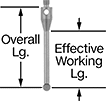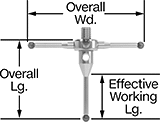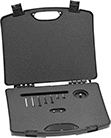Filter by
End Material
Stem Material
Manufacturer Model Number
Export Control Classification Number (ECCN)
DFARS Specialty Metals
Probe Styli
Our most general purpose probe styli, these Renishaw styli are used with both touch-trigger and scanning probes. When these styli touch your workpiece, they trigger your probe to send a signal and measure geometric features. The ball end is made of ruby, which is second only to diamond in hardness, so it won’t lose its shape or wear over time. It’s completely round and smooth to avoid touching your workpiece at more than one precise point, preventing inaccurate measurements. However, these probe styli don’t work well with aluminum or cast iron surfaces. Aluminum can rub off onto the ruby, and cast iron and ruby are prone to scratching each other during scanning jobs.
As a rule of thumb, you should choose a stylus with the shortest length and largest ball-end diameter that works for your application. If a stylus is too long, it’s more likely to move farther than it should, reducing measurement accuracy. Larger ball ends reduce the possibility that the stem will accidentally touch your workpiece and interfere with the reading.
Ruby Ball-End Styli
 |
M3 Mounting Thread—Styli with M2 or M3 threads are often used in coordinate measuring machines (CMMs).
Tungsten Carbide Stem—Tungsten carbide stems are the stiffest and least likely to flex. Tungsten carbide can slightly expand in changing temperatures, so if you need precise measurements, use these styli in temperature-controlled environments.
Carbon Fiber Stem—Carbon fiber stems are the most lightweight option, so they’re often found on longer styli.
Material | Ball | ||||||||||||||||||||||||||||||||||||||||||||||||||||||||||||||||||||||||||||||||||||||||||||||||||
|---|---|---|---|---|---|---|---|---|---|---|---|---|---|---|---|---|---|---|---|---|---|---|---|---|---|---|---|---|---|---|---|---|---|---|---|---|---|---|---|---|---|---|---|---|---|---|---|---|---|---|---|---|---|---|---|---|---|---|---|---|---|---|---|---|---|---|---|---|---|---|---|---|---|---|---|---|---|---|---|---|---|---|---|---|---|---|---|---|---|---|---|---|---|---|---|---|---|---|---|
End Dia., mm | Effective Working Lg., mm | Overall Lg., mm | Stem Dia., mm | Stem | Body | End Dia. Tolerance, mm | Precision Grade | Sphericity Tolerance, mm | Mfr. | Mfr. Model No. | Each | ||||||||||||||||||||||||||||||||||||||||||||||||||||||||||||||||||||||||||||||||||||||||
M3 × 0.5 mm | |||||||||||||||||||||||||||||||||||||||||||||||||||||||||||||||||||||||||||||||||||||||||||||||||||
| 1 | 4 | 21 | 0.7 | Stainless Steel | Stainless Steel | -0.00013 to 0.00013 | 5 | -0.00013 to 0.00013 | Renishaw | A-5000-3551 | 85175A576 | 000000 | |||||||||||||||||||||||||||||||||||||||||||||||||||||||||||||||||||||||||||||||||||||||
| 1.5 | 22.5 | 30 | 1 | Tungsten Carbide | Stainless Steel | -0.00013 to 0.00013 | 5 | -0.00013 to 0.00013 | Renishaw | A-5003-0051 | 85175A609 | 00000 | |||||||||||||||||||||||||||||||||||||||||||||||||||||||||||||||||||||||||||||||||||||||
| 2 | 9.6 | 21 | 1.4 | Stainless Steel | Stainless Steel | -0.00013 to 0.00013 | 5 | -0.00013 to 0.00013 | Renishaw | A-5000-3552 | 85175A589 | 00000 | |||||||||||||||||||||||||||||||||||||||||||||||||||||||||||||||||||||||||||||||||||||||
| 2 | 32.5 | 40 | 1.5 | Tungsten Carbide | Stainless Steel | -0.00013 to 0.00013 | 5 | -0.00013 to 0.00013 | Renishaw | A-5003-0053 | 85175A614 | 00000 | |||||||||||||||||||||||||||||||||||||||||||||||||||||||||||||||||||||||||||||||||||||||
| 3 | 14.7 | 21 | 1.5 | Stainless Steel | Stainless Steel | -0.00013 to 0.00013 | 5 | -0.00013 to 0.00013 | Renishaw | A-5000-3553 | 85175A597 | 00000 | |||||||||||||||||||||||||||||||||||||||||||||||||||||||||||||||||||||||||||||||||||||||
| 10 | 75 | 75 | 4 | Carbon Fiber | Stainless Steel | -0.00013 to 0.00013 | 5 | -0.00013 to 0.00013 | Renishaw | A-5003-7057 | 6193N57 | 000000 | |||||||||||||||||||||||||||||||||||||||||||||||||||||||||||||||||||||||||||||||||||||||
| 12 | 100 | 100 | 4 | Carbon Fiber | Stainless Steel | -0.00013 to 0.00013 | 5 | -0.00013 to 0.00013 | Renishaw | A-5003-7445 | 6193N58 | 000000 | |||||||||||||||||||||||||||||||||||||||||||||||||||||||||||||||||||||||||||||||||||||||
Ruby Ball/Star-End Styli
 |
5 Styli |
Ball/star styli combine up to 5 styli in one, so you can reach more of your workpiece at once. This means you won’t have to swap out styli as many times during a job. They are commonly used to inspect bores, shoulders, and grooves.
M3 Mounting Thread—Styli with M2 or M3 threads are often used in coordinate measuring machines (CMMs).
Material | Ball | ||||||||||||||||||||||||||||||||||||||||||||||||||||||||||||||||||||||||||||||||||||||||||||||||||
|---|---|---|---|---|---|---|---|---|---|---|---|---|---|---|---|---|---|---|---|---|---|---|---|---|---|---|---|---|---|---|---|---|---|---|---|---|---|---|---|---|---|---|---|---|---|---|---|---|---|---|---|---|---|---|---|---|---|---|---|---|---|---|---|---|---|---|---|---|---|---|---|---|---|---|---|---|---|---|---|---|---|---|---|---|---|---|---|---|---|---|---|---|---|---|---|---|---|---|---|
No. of Styli | End Dia., mm | Effective Working Lg., mm | Overall Lg., mm | Overall Wd., mm | Stem Dia., mm | Stem | Body | End Dia. Tolerance, mm | Precision Grade | Sphericity Tolerance, mm | Mfr. | Mfr. Model No. | Each | ||||||||||||||||||||||||||||||||||||||||||||||||||||||||||||||||||||||||||||||||||||||
M3 × 0.5 mm | |||||||||||||||||||||||||||||||||||||||||||||||||||||||||||||||||||||||||||||||||||||||||||||||||||
| 5 | 2 | 12 | 21.5 | 30 | 1.4 | Stainless Steel | Stainless Steel | -0.00013 to 0.00013 | 5 | -0.00013 to 0.00013 | Renishaw | A-5003-0076 | 6193N59 | 0000000 | |||||||||||||||||||||||||||||||||||||||||||||||||||||||||||||||||||||||||||||||||||||
Probe Styli Kits
 |
Keep a variety of common Renishaw stylus sizes, extensions, and tools on hand. When styli touch a workpiece, they trigger your probe to send a signal and measure geometric features.
Make sure the thread size of the styli in the kit you choose fits your application.
These kits all include ruby ball styli, which can be used in a wide variety of applications, from touch-trigger to scanning probes. Ruby is second only to diamond in hardness, so the ball end won’t lose its shape or wear over time. It’s completely round and smooth to avoid touching your workpiece at more than one precise point, preventing inaccurate measurements. However, these probe styli don’t work well with aluminum or cast iron surfaces. Aluminum can rub off onto the ruby, and cast iron and ruby are prone to scratching each other during scanning jobs.
As a rule of thumb, you should use a stylus with the shortest length and largest ball-end diameter that works for your application. If a stylus is too long, it’s more likely to move farther than it should, reducing measurement accuracy. Larger ball ends minimize the risk that the stem will accidentally touch your workpiece and interfere with the reading.
All kits come with stylus installation tools, which give you a handle to turn so it’s easier to thread a stylus into your probe. Slide them into the hole at the top of your probe stylus. The included stylus extensions are useful if you need to reach deep or difficult-to-access areas.
EWL (effective working length) is measured from the beginning of the stem to the center of the ball or disc end.
M3 Mounting Thread—Styli with M2 or M3 threads are often used in coordinate measuring machines (CMMs).
One 35 mm Dia. × 5 mm Thick. High-Carbon Steel Disc Stylus—Disc styli fit in undercuts and grooves within bores that are too narrow for ball styli. However, because the stylus end is flat, they can’t measure in as many directions as ball styli. Use them with both touch-trigger and scanning probes.
No. of Pieces | Includes | Container Type | Body Material | Mfr. | Mfr. Model No. | Each | |||||||||||||||||||||||||||||||||||||||||||||||||||||||||||||||||||||||||||||||||||||||||||||
|---|---|---|---|---|---|---|---|---|---|---|---|---|---|---|---|---|---|---|---|---|---|---|---|---|---|---|---|---|---|---|---|---|---|---|---|---|---|---|---|---|---|---|---|---|---|---|---|---|---|---|---|---|---|---|---|---|---|---|---|---|---|---|---|---|---|---|---|---|---|---|---|---|---|---|---|---|---|---|---|---|---|---|---|---|---|---|---|---|---|---|---|---|---|---|---|---|---|---|---|
M3 × 0.5 mm | |||||||||||||||||||||||||||||||||||||||||||||||||||||||||||||||||||||||||||||||||||||||||||||||||||
High-Carbon Steel End, Ruby End | |||||||||||||||||||||||||||||||||||||||||||||||||||||||||||||||||||||||||||||||||||||||||||||||||||
| 10 | One 1 mm Dia. Ruby Ball Stylus with Stainless Steel Stem—21 mm O'all Lg. (4 mm EWL) One 2 mm Dia. Ruby Ball Stylus with Tungsten Carbide Stem—40 mm O'all Lg. (32.5 mm EWL) One 3 mm Dia. Ruby Ball Stylus with Tungsten Carbide Stem—50 mm O'all Lg. (43.7 mm EWL) One 4 mm Dia. Ruby Ball Stylus with Tungsten Carbide Stem—40 mm O'all Lg. (36 mm EWL) One 5 mm Dia. Ruby Ball Stylus with Stainless Steel Stem—21 mm O'all Lg. (21 mm EWL) One 5 mm Dia. Ruby Ball Stylus with Ceramic Stem—50 mm O'all Lg. (50 mm EWL) One 35 mm Dia. × 5 mm Thick. High-Carbon Steel Disc Stylus One 50 mm Lg. Stylus Extension Two Stylus Installation Tools | Plastic Case | Stainless Steel | Renishaw | A-5004-6880 | 6193N34 | 0000000 | ||||||||||||||||||||||||||||||||||||||||||||||||||||||||||||||||||||||||||||||||||||||||||||
Probe Styli for Undercuts and Grooves
 |
Slip these Renishaw styli into undercuts and grooves that are too narrow for other styli. When the side of the disc touches your workpiece, these styli trigger your coordinate measuring machine (CMM) probe to send a signal and measure geometric features. The disc is completely round, just like a ball stylus, so these styli contact your workpiece with the same precision. However, they can’t measure in as many directions as ball styli. When space is tight, they’re a great alternative to star styli for inspecting features inside holes. They work with both touch-trigger and scanning probes.
High-Carbon Steel Disc-End Styli
 |
Stylus |
End, mm | Material | ||||||||||||||||||||||||||||||||||||||||||||||||||||||||||||||||||||||||||||||||||||||||||||||||||
|---|---|---|---|---|---|---|---|---|---|---|---|---|---|---|---|---|---|---|---|---|---|---|---|---|---|---|---|---|---|---|---|---|---|---|---|---|---|---|---|---|---|---|---|---|---|---|---|---|---|---|---|---|---|---|---|---|---|---|---|---|---|---|---|---|---|---|---|---|---|---|---|---|---|---|---|---|---|---|---|---|---|---|---|---|---|---|---|---|---|---|---|---|---|---|---|---|---|---|---|
Dia. | Thk. | Overall Lg., mm | Stem Dia., mm | Stem | Body | End Dia. Tolerance, mm | Mfr. | Mfr. Model No. | Each | ||||||||||||||||||||||||||||||||||||||||||||||||||||||||||||||||||||||||||||||||||||||||||
M3 × 0.5 mm | |||||||||||||||||||||||||||||||||||||||||||||||||||||||||||||||||||||||||||||||||||||||||||||||||||
| 35 | 5 | 6.5 | 7 | Stainless Steel | Stainless Steel | -0.001 to 0.001 | Renishaw | A-5000-7612 | 6193N16 | 0000000 | |||||||||||||||||||||||||||||||||||||||||||||||||||||||||||||||||||||||||||||||||||||||||
Large Diameter Probe Styli
Probe large bores and deep features—these Renishaw styli have a contact surface that’s 1.5x the size of that on our largest ball styli. When they touch a workpiece, they trigger your coordinate measuring machine (CMM) probe to send a signal and measure geometric features. The size of the half ball keeps the stem from accidentally touching your part, preventing your probe from falsely triggering and measuring inaccurately. It also evens out the inconsistencies from measuring rough and textured surfaces, making these styli a good choice for use on threads. To minimize their weight, the half ball is hollow and made of lightweight ceramic.



























